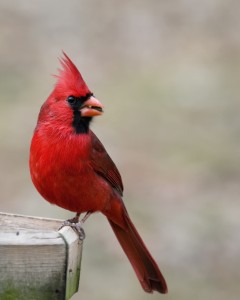
Cardinals Resonate in the Hearts of the People Who Observe Them
When a family visits our store interested in attracting a certain bird, it’s always a special experience to guide them in their quest. One family in particular will always stand out to me, as they were hoping to attract cardinals in honor of a late family member who adored this vermilion-bathed bird. This interest opened up a robust discussion on cardinals… what are they like, and why do we love them so much?
Although one of the most common sought-after backyard feeder birds, the Northern Cardinal still boasts some noteworthy ecology in the bird world. Permanent residents in the Twin Cities, cardinals have gradually expanded northward in the past 100 years, with the Minnesota’s first recorded sighting occurring in 1875. Typically foraging as ground feeders, cardinals prefer a sizable tray or perch when it comes to backyard feeders. At this time of year they’ll be on the lookout for dense foliage for nesting, in which cardinals can rear 2-5 eggs up to twicet each year. Once courtship is complete, the female scopes out various sites, with the male following close behind and equipped with nesting material. While the female is one of the few female North American songbirds that sing, the male is known for voraciously defending it’s territory. If you see a male cardinal attacking it’s reflection in a window, it’s probably time for some deterring window decals or tape to break up their reflection. Similar to wrens, a mated pair of cardinals share song phrases unique only to them (honey, that’s our song!).
But beyond the ecology, cardinals are also well versed in culture and folklore. With a name deriving from the resemblance of Vatican priests’ robes, cardinals have long been seen as a symbol of faith, cheer, strength, communication, and duty. The word cardinal derives from the Latin word cardo, meaning hinge/axis, and the Greek word kardia, meaning heart. While these may seem unrelated, this Latin phrase cardo refers to the place from which something is moved, such as a door. The heart, the kardia, then of course governs and moves a person in the same way. Could this be why we love cardinals so much?
When the human story converges with that of ecology, the phenomenon of birding occurs. While at times this phenomenon manifests in the form of a parent who’s delved into a quirky hobby, perhaps it’s the parents, in their lived experience as such, who are most receptive to all the cardinal truly has to offer. Perhaps the art of birding—finding joy in the fleeting, intricate, and heart-felt details—is something our world needs now more than ever.
CONTRIBUTED BY STAFF MEMBER NICK VOSS
Sources:
Cornel Lab of Ornithology: www.allaboutbirds.org
National Audobon Society: www.audobon.org
The Cardinal Experience: www.thecardinalexperience.com

